All 1 entries tagged Mount Athos
No other Warwick Blogs use the tag Mount Athos on entries | View entries tagged Mount Athos at Technorati | There are no images tagged Mount Athos on this blog
December 06, 2014
The festival of Saint Nicholas
December 6th, right after term ends, when students and teachers start relaxing, is Saint Nicholas’ day. This saint and bishop of Myra in Asia Minor (c. AD 270-343), famous as the patron of children and young people, is a worthy star for December’s coin of the month. Indeed, who does not know at least one of the legends related to his deeds?
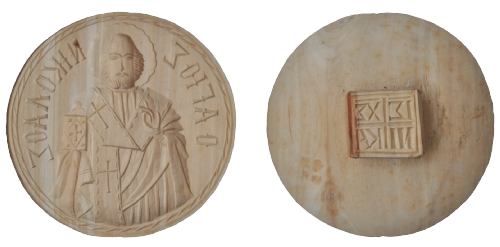 |
Wooden bread stamp from Mount Athos, a gift to the author by G. Poupon from Saint-Maurice, who visited Mount Athos in 1982. Obverse: Ο ΑΓΙΟΣ ΝΙΚΟΛΑΟΣ with bust of Saint Nicholas — Reverse: square handle with Christogramm IΣ − XΣ / NI − KA.
One legend records Saint Nicholas resurrecting three boys cruelly murdered by a butcher who put them into barrels to sell them as ham. In another he saves three girls from prostitution. Their father was too poor to afford a dowry, and remaining unmarried, the daughters (without proper employment) may have had no other method to secure their incomes. Saint Nicholas provided the money by secretly placing three purses filled with coins in their house overnight; according to one version of the legend he dropped the money though the chimney and it fell into stockings. Therefore he is often depicted with three purses, and he became the patron of bankers as well. Other legends refer to the saint as offering assistance during distress at sea: therefore he is also the protector of sailors and of fishermen.
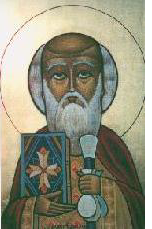 |
A Coptic icon with Saint Nicholas holding three purses.
Many generations have been told and will still tell the stories about Saint Nicholas. His generosity and care for children transformed him into Father Christmas, Santa Claus or simply ‘Santa’, who brings good things to children. He is probably one of the most popular saints. Although today’s western society has made him an icon of a commercial-style Christmas (starting earlier and earlier every year), other traditions keep Saint Nicholas’ stories alive. Thus sweets are put into stocks or into boots in remembrance of the legend about the three daughters. Artists commemorated the saint with amazing paintings, and composers with outstanding music. One piece of music I especially recommend is Benjamin Brittens’ Saint Nicholas cantata, here recorded with many lovely pictures taken of the saint and his legends.
Here we look at two contemporary depictions of Saint Nicholas on coin-like items. The first one is a wooden bread stamp from Mount Athos with a bearded bust of Saint Nicholas. He is dressed as a bishop of the Eastern Orthodox church with the omophorion (a garment similar to a stola) embroidered with four big crosses, holding a book and in the act of blessing. The saint is bareheaded, as he was shown in the Eastern, Byzantine world. The Greek legend Ο ΑΓΙΟΣ ΝΙΚΟΛΑΟΣ (‘The Saint Nicholas’) helps the viewer further to identify the saint. It is retrograde because the mould is a negative image. The mould has a reverse just like a coin: on the reverse is a handle inscribed IΣ − XΣ / NI − KA: ‘Jesus Christ is victorious’. This is a formula used in the holy communion of the Orthodox Church. Stamps with this formula are used to stamp bread for the Eucharist. This mould combines the christogram with Saint Nicholas’ bust. Both were used to stamp bread baked upon the occasion of his feast.
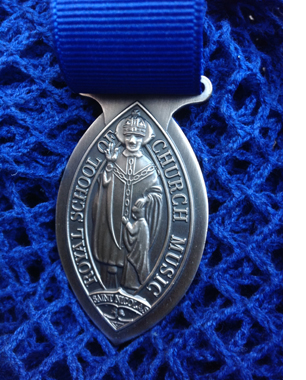 |
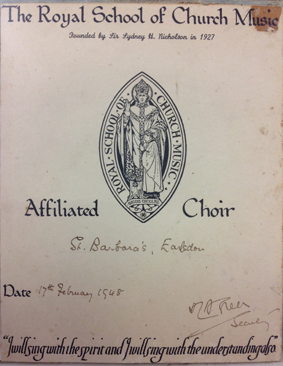 |
Music award of the Royal School of Church Music and emblem with Saint Nicholas blessing a child chorister.
In the Latin world, Saint Nicholas is represented as a western bishop with the mitre and pallium as shown on the second item, an almond-shaped medal. He is blessing a small figure kneeling in front of him and the inscription makes clear who the saint is (‘SAINT NICOLAS’). The legend also records that the medal is from the Royal School of Church Music. I initially wondered why this institution does not have Saint Caecilia on their medals. But the medals are awards originally designed for children choristers—therefore Saint Nicholas is a perfect design for the medal.
For Classicists it is noteworthy that Saint Nicholas is said to have destroyed Myra's renowned temple of Artemis and that his feast reaplced that of Artemis. A church was built over his tomb in Myra, and his relics are in many churches all over the world, creating new cults and new identities. In recent years Turkey has tried to claim them back for Myra.
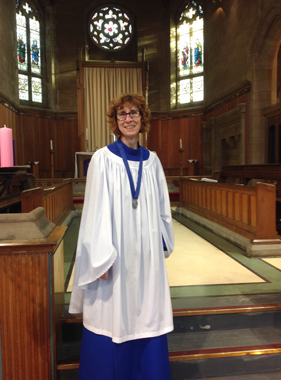 |
This month’s coin was chosen by Suzanne Frey-Kupper, Associate Professor of Numismatics and Classical Archaeology at the Department of Classics and Ancient History at the University of Warwick. She works on Greek, Punic and Roman coinage from the Western Mediterranean and the North-Western provinces. She has published the coin finds from many major archaeological sites, including medieval and modern coins and medals. Living in Coventry since 2011, she is a member of the choir of Saint Barbara, Earlsdon.
Further reading:
Cioffari , G. (1987) San Nicola nella Critica Storia (Bari : Centro Studi Nicolaiani)
Galavaris, G. (1970) Bread and the Liturgy. The Symbolism of Early Christian and Byzantine Bread Stamps (Madison & London: The University of Wisconsin Press)
Travaini, L. (2013) ‘Coins as bread. Bread as coins’, Numismatic Chronicle 173, 2013: 187-200
 Clare Rowan
Clare Rowan

 Please wait - comments are loading
Please wait - comments are loading

 Loading…
Loading…

